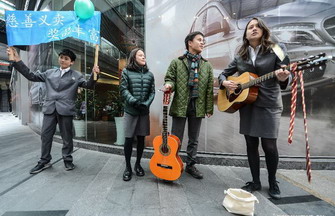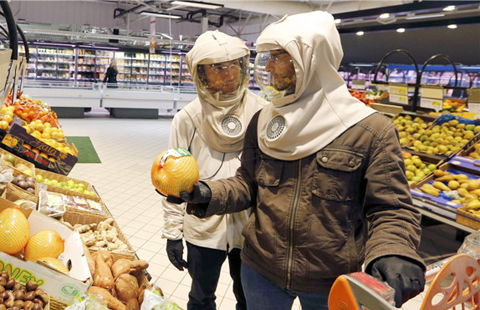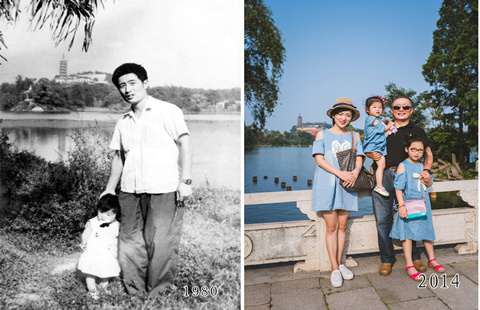China-made subway train arrives in Rio for Olympics
Updated: 2015-02-09 05:12
By JI Ye in Rio de Janeiro(China Daily Latin America)
|
||||||||
The first specially designed subway train made in China for the 2016 Summer Olympic Games to connect Rio de Janeiro with the Olympic village has arrived three months after being shipped.
The train was unloaded in the Olympic host city on Jan 28 and it is expected to be put into operation at the end of March or in early April, according to China CNR Corporation Ltd, the train’s manufacturer.
CNR, one of China’s biggest train makers, started to research the Latin American market in 2004. In 2007, Rio was chosen to host the 2014 World Cup and 2016 Summer Olympics. Then the government of Rio vowed to improve the city's rail network within five years, and in 2009, began to sign contracts with CNR for the China-made vehicles, with CNR winning the bid competition over Siemens and Alstom.
CNR was given orders for 100 electric multiple units (EMU), a type of intercity high-speed train, and 34 subway trains for Rio over the past six years. Those vehicles will make up 82 percent of Rio’s urban mass transit.
CNR delivered the first subway trains to upgrade Brazil's transportation network for the 2014 football World Cup. The trains transported the public between Rio’s central station and Maracana Stadium.
CNR’s subway trains will be used in the summer games on Line 4 between the Olympic Village and the Copacabana game center. The line is a key infrastructure project for the upcoming games. It is still under construction, and is scheduled to start operating in time for the games, which will take place from Aug 5 to Aug 21.
When opened, the new line will link the Olympic Park with Ipanema in the south zone, and provide Rio residents with connections to Copacabana, the city center and the north zone.
Its six new stations will integrate with the existing subway Lines 1 and 2, shortening travel from Barra to Ipanema to 15 minutes, and from Barra to the city center to 34 minutes.
The State of Rio de Janeiro promised the International Olympic Committee that Line 4 would be completed before the Olympics start. CNR delivered the subway train ahead of the contracted delivery date to ensure the rail system's operation before the opening of Line 4.
It will mark the first time a Chinese train maker has taken part in an Olympic Games’ transportation system outside of China. To meet requirements and win contracts, CNR offered more high technology, cost-efficient solutions and special adjustments to meet Rio’s needs.
Comprised of six cars, the newly arrived subway train can carry 2,240 passengers at a maximum speed of 100 km (62 miles per hour). The train is equipped with an over-speed protection device, which automatically sounds an alert and helps slow down the train when the speed limit is reached.
Made of A-type stainless steel, the subway train has a far greater compression load than a normal train, ensuring passengers' safety in the event of a head-on collision, for example, with an 80-ton truck running at a speed of 36 km per hour.
To withstand the Brazilian heat, the train is equipped with China's first single air-conditioning unitthat will allow it to operate in temperatures as high as 56 degrees Celsius (132 Fahrenheit).
Instead of normal glass in its windows and doors, the train uses polyester glass to prevent unruly passengers from breaking them after watching sports matches.
CNR was created following a reorganization of the China Northern Locomotive and Rolling Stock Industry (Group) in June 2008. Its products are used in more than 40 countries and regions.
- China seeks compensation from Mexico after high-speed project suspended
- Brazil in 'eclipse', China 'shines': Expert
- China to build two nuclear power plants in Argentina
- Sri Lanka in U-turn on port project
- Russia expresses optimism about solution to Ukraine issue
- China urges continued dialogue on Kosovo issue
Most Viewed
Editor's Picks

|

|

|

|

|

|
Today's Top News
China seeks compensation from Mexico after high-speed project suspended
China to build two nuclear power plants in Argentina
Xi plans to make state visit to US
Trade numbers take big hit in January
Search continues for 3 missing in TransAsia crash
'Most Beautiful' girl loses battle with cancer
Three more H7N9 cases reported in China's Guangdong
US invites President Xi for state visit
US Weekly

|

|















